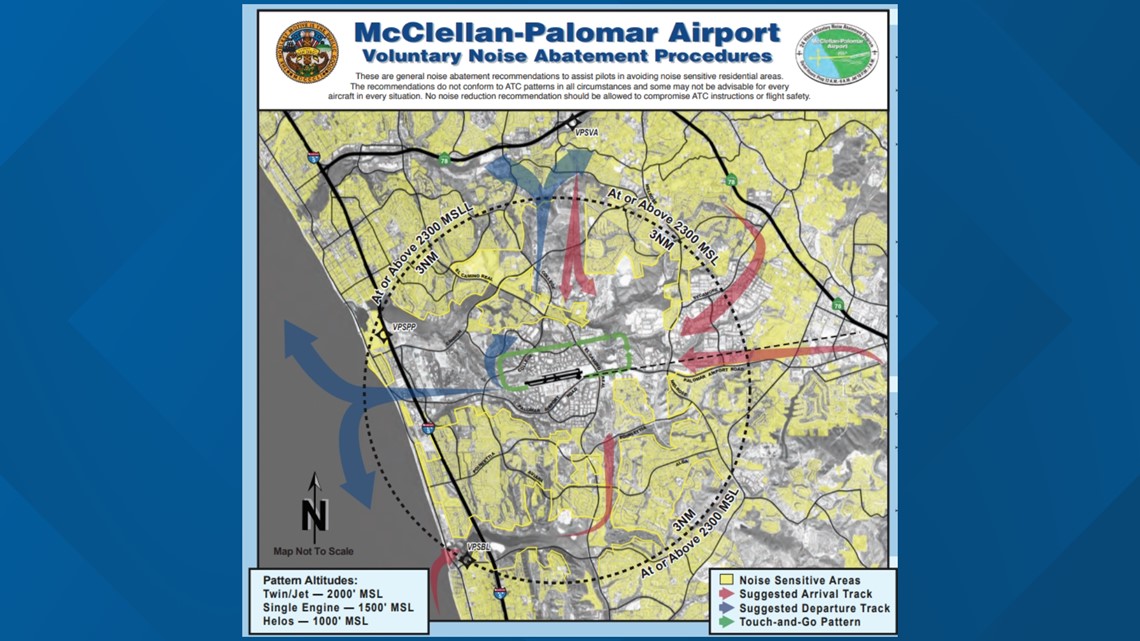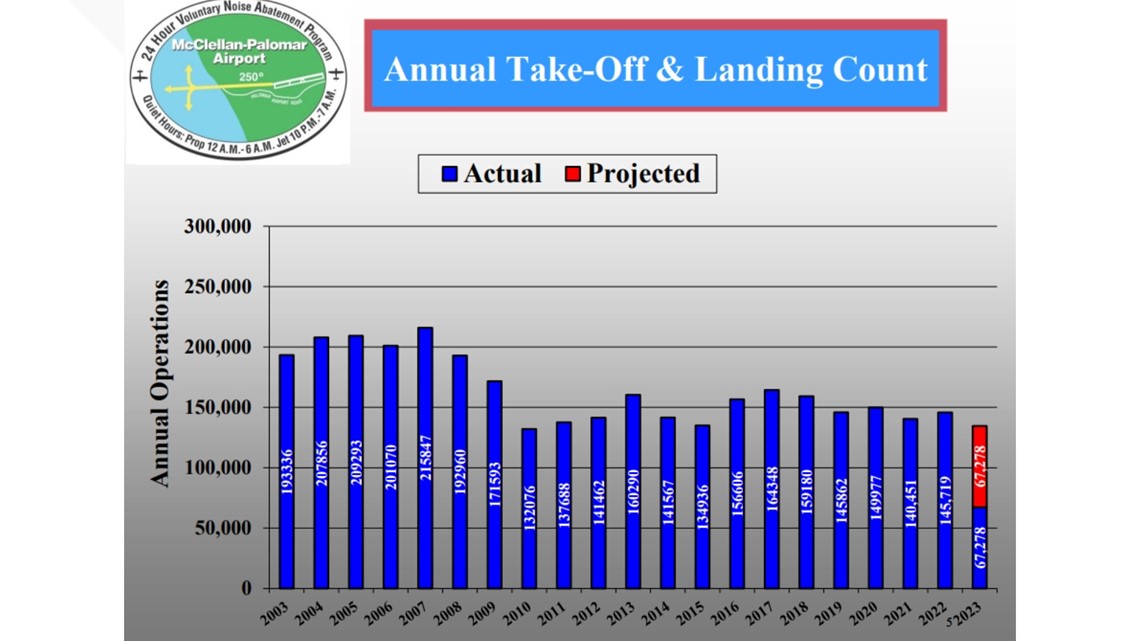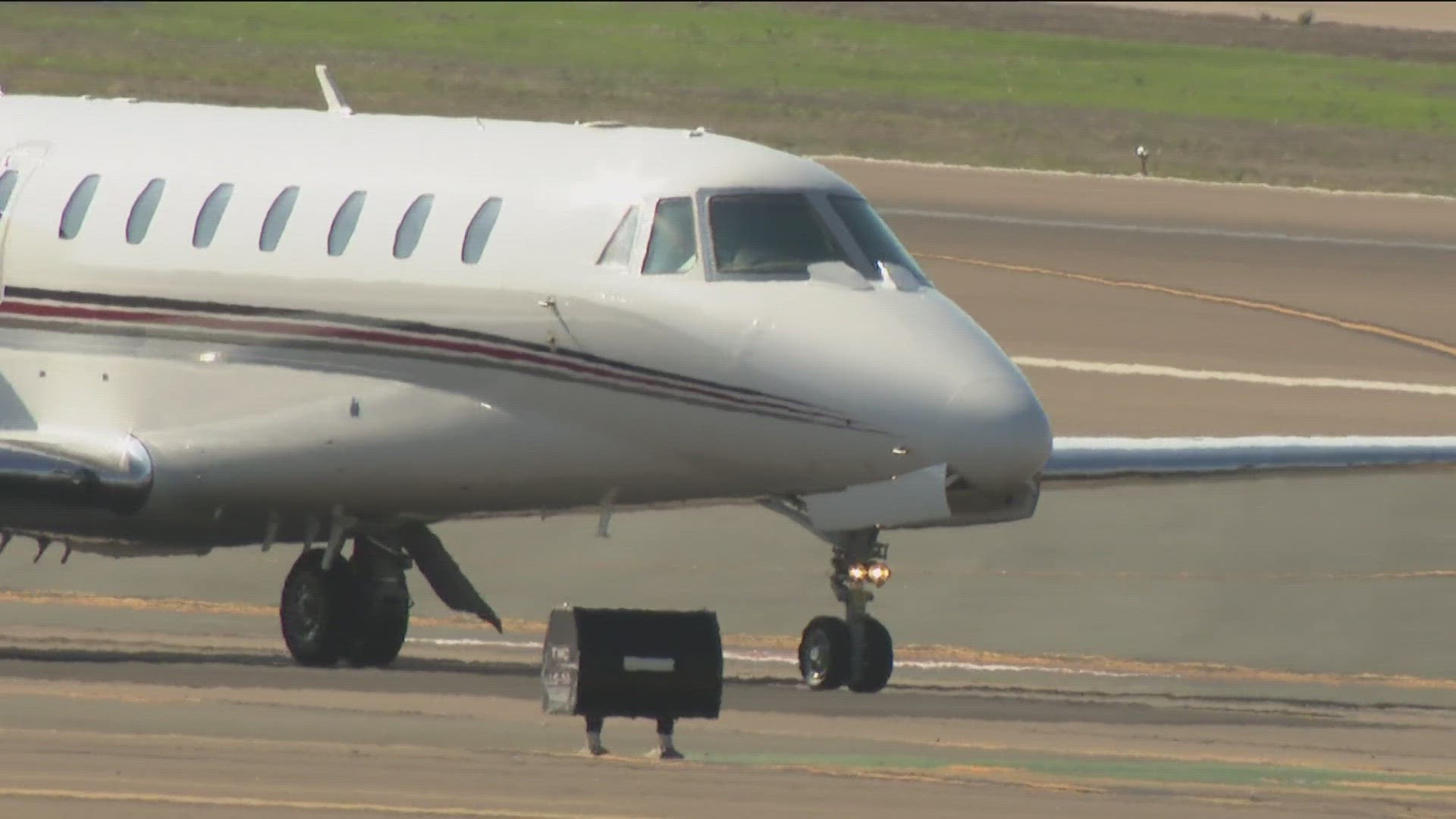CARLSBAD, Calif. — "This is the wild west. Pilots can fly in and out whenever they want. There are no consequences for deviating from the flight paths. There are no consequences from taking off and landing whenever pilots please," said Vickey Syage, one of thousands of Carlsbad residents who live within miles of McClellan-Palomar Airport and say the airport and the pilots are buzzing neighborhoods and schools below, altering dedicated flight paths, and ignoring voluntary noise curfews with no enforcement from the Federal Aviation Administration or the county of San Diego.
Syage, president of the Citizens for a Friendly Airport, as well as homeowners from 16 housing communities within a three-mile radius of the airport, have banded together in hopes of ramping up enforcement at the regional, county-owned airport.
Over the course of the past eight years, the group says the county and Federal Aviation Administration have allowed pilots to fly untethered from any rules and without any fear of enforcement.
That has left many residents fearful that a tragedy can occur not over the dedicated flight path which runs due west above Palomar Airport Road, out over the ocean before banking north or south depending on the plane's destination but over homes, schools and playgrounds in communities near the airport.
"We have multiple new schools," said Syage. "We probably have 5,000-to-7000 students that are in the new deviated flight paths. And those schools are relatively new, all built within the last 15 years. The community has grown around the airport and these deviations are unsafe.


Carlsbad resident Dom Betro has turned into a regular planespotter whose hobby, more like a full-time job, of watching airplanes take off from his home.
"My house sits in the path of the takeoff flight pattern," said Betro. "I look out my window I see nine out of 10 of them deviate when they go south and cut the turn short and come over all the houses from Poinsettia Avenue to Palomar Airport Road. We have these flights, sometimes within 500 to 1000 feet of playgrounds and schools, where kids are outside playing, and there's documented evidence that that is not a good thing."
In addition to the safety concerns, residents say that allowing pilots to deviate from the flight path results in more noise for surrounding neighborhoods.
But that is not all. Residents also say the County of San Diego, the airport owner and operator, has declined to implement a mandatory curfew on incoming and outgoing flights from the Carlsbad airport, similar to those at San Diego International, John Wayne Airport in Orange County, Long Beach, Ontario, among other California airports. Instead, the county has implemented what is known as a "Voluntary Noise Abatement Curfew," which requests that pilots do not take off or land between the hours of 10:00 p.m. to 7:00 a.m.
According to numbers obtained by CBS 8, McClellan Palomar Airport less than one percent of all flights in and out of McClellan Palomar Airport occur during voluntary quiet hours, for jets from 10 p.m. to 7 a.m. and for propeller planes from 12 a.m. to 6 a.m.
However, considering that there are approximately 11,580 flights per month and an average of 80.6 after-hour flights per month, that results in nearly three flights per day during the hours of 10 p.m. and 7 a.m., depending on the type of plane.


And then there's the other separate but related issue of public safety from pilots jettisoning dedicated flight paths and veering over neighborhoods around the airport.
Holding those pilots accountable, say residents, is easier said than done.
"We get a lot of bureaucratic answers, just your basic 'cover your ass' type responses from the Federal Aviation Administration and the county of San Diego," says resident Dom Betro, who has advocated for a quieter airport for several years. "Everybody points the finger at somebody else. They tell us, 'We can only do this, and the FAA is responsible for that.'"
Added Betro, "When push comes to shove they tell us that flight patterns and minding voluntary curfews is at the pilot's discretion in case there are safety issues at hand."
It is the back and forth that Betro, Syage and thousands of others say has landed them into a constant state of dead-air space and for that reason, he and others have urged Congressman Mike Levin to get involved and encourage the Federal Aviation Administration for better oversight of the airport.
"I will be candid with you, the FAA needs to do more," Congressman Levin told CBS 8. "We are going to hold them accountable and make sure they're being responsive to address the real concerns of our constituents."
The congressman said that he directed his staff to work with the FAA to make sure that pilots were informed about the voluntary noise program and the need to follow dedicated flight patterns and comply with take-off times and landings.
While applauding the countless hours that residents have put into their efforts to report low-flying planes and late take-off and landing times, Congressman Levin says they should not be responsible for monitoring the airport so closely and that the FAA should be enforcing these issues already.
"One thing is for sure, it shouldn't be up to citizens to enforce safety rules, it really needs to be the FAA's responsibility," Levin told CBS 8. "The FAA needs to be accountable."
But Levin says the county of San Diego also needs to act to ensure the safety of nearby residents.
"There's simply no excuse. Some of these pilots that are endangering residents, even school kids, need to be held to account, and the county has to protect public safety. It should be pretty simple. We need to be making sure that we're holding anybody accountable who's not flying at sufficient altitude, and we need to be sending that signal to our pilots that they need to be flying in accordance with the rules."
Levin's comments and work on behalf of residents confirm what residents have witnessed; a back-and-forth between the county and the FAA as to who is responsible for what.
"The community is fatigued. They know these complaints go nowhere," said resident Frank Sung who has filed countless complaints for low and late-flying planes. We're not trying to shut things down. We're just trying to get the airport to be a friendly neighbor to the community."
Added Sung, "Praise God we haven't had any crashes. These pilots may be flying 1,000 feet above sea level, but there are some hills around here, and you are only 500 to 700 feet above the homes. That margin to recover from an engine problem is very little."
Federal Aviation Administration vs. The County of San Diego
So, who does have authority over McClellan Palomar and what needs to happen?
CBS 8 reached out to the FAA and the county of San Diego in search of answers to the issues of noise and safety issues involving low-flying planes and pilots who decide to deviate from the standard flight paths and fly over neighborhoods and schools.
Noise
In terms of noise, the FAA says it is the county that needs to act and enforce any noise issues.
In a statement, a spokesperson for the FAA told CBS 8, "The County of San Diego owns McClellan-Palomar Airport. The FAA does not have the legal authority to force pilots to comply with the county’s voluntary noise abatement program. The county is responsible for monitoring and investigating pilots who do not comply with the voluntary noise program. The FAA does not implement curfews."
The spokesperson for the Federal Aviation Administration said that in order to implement a mandatory curfew the county of San Diego needs to formally request that one be put into place, something that the FAA says it has not done.
"San Diego County would decide whether to pursue a mandatory curfew. They have not formally requested one."
It is not so simple, says the county of San Diego. In fact, a spokesperson tells CBS 8 that it "requested" a mandatory curfew on two occasions, most recently in December 2021, and the FAA encouraged a voluntary noise curfew instead.
And while the county spokesperson says it can submit another formal request for a mandatory curfew, a time-consuming and laborious effort that includes the need for a cost-benefit study among other things, the spokesperson says the county is confident that it will continue to cut down on the noise around the airport.
"We currently do not plan to change our voluntary program," said the county spokesperson. "Since 2000, Palomar Airport has become a quieter airport due to a decrease in airport operations from an average of 205,000 operations in the mid-2000s to 146,000 in 2022. Also, advancements made in aircraft and engine designs have contributed to a quieter airport."
Both county and FAA officials do agree on one thing, establishing a mandatory curfew is no simple task.
That's because in 1990 the U.S. Congress passed a law that made it more difficult for local jurisdictions and airports to implement noise restrictions at airports.
The county spokesperson told CBS 8 that it is dedicated to keeping noise levels down at the airport and making sure pilots abide by the noise ordinance.
"Palomar Airport is committed to being a good neighbor and has taken proactive steps with its flight operators to limit noise," said the spokesperson. "Although the FAA has exclusive jurisdiction over aircraft noise from aircraft in flight, the County regularly encourages aircraft pilots to adhere to the operating hours."
Low-Flying Planes
As to low-flying planes and the community's complaints about pilots foregoing the flight pattern, the county says it is the FAA's responsibility to ensure that pilots comply with safety standards.
The airport, said the county's spokesperson, has also met with pilots to drive home the requirements for aircraft approaches and take-offs. The most recent meeting occurred on August 29, when airport and FAA officials met with 60 pilots to discuss flight paths and elevation issues.
"Palomar Airport regularly asks that aircraft approach the airport at 2,000 feet above the ground within a 3-mile radius to help avoid noise or altitude concerns by the public.
Residents, such as Vickey Syage, want a mandatory curfew and assurances that pilots who do fly off course are disciplined in order to keep them and their loved ones safe from a potential tragedy.
"No one's trying to shut it down," said Syage. "We want it to go back and be the airport that it was when we all moved here that this was supposed to just be a small-plane airport with flight flights that flew during daylight hours, straight out to the ocean, and and then turned left or right. Not ones that go over the houses or wake you up in the middle of the night."

